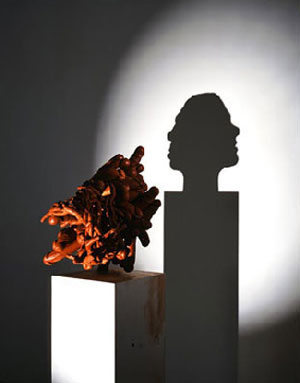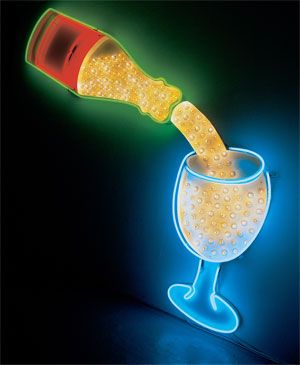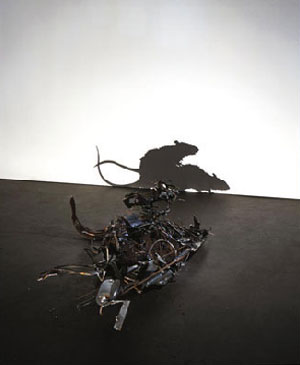It was appropriate that George Michael played a live concert at the American Center in Dallas the day after Glasstire’s interview with Tim Noble and Sue Webster. Post-YBA Brit artists and pop rockers in their own right, Noble and Webster were psyched about Michael’s imminent performance. These two international artists, married in their work and real life and giddy with caffeine, were just in from a tour of the grassy knoll and about to be interviewed at the Goss-Michael Foundation, former gallery now public art collection owned by Michael and his partner, Dallas native Kenny Goss. Pop-rock stars seemed to be aligned. Noble and Webster had tickets to the concert and they love pop (especially balmy hep vocalists like Michael), glitzy places like Vegas and devalued things like the American dollar. Having hobnobbed the night before, Noble said, "he’s a good talker," referring to Michael.
Before they were partnered in marriage, Noble and Webster were partnered in art. They met in 1986 at art school in Nottingham and have been intentionally skirting the edges of the London art world ever since. The exhibition of their work at The Goss-Michael Foundation is small but delightful. One of three neon signs in the show, The Sweet Smell of Excess, is bright and bubbly: a would-be Vegas sign made to scale of a champagne bottle pouring its contents into a glass. It’s installed in a window facing the corner of Cedar Springs and Fairmount — not so much for pedestrians to muse over, but for car drivers to be distracted by. The window installation makes Noble and Webster’s already puckish work downright brash. Thanks to this type of installation, a sign is as a sign should be: drive-by, fast-food art.
Looking for contemplation? Then step inside. Front and center, Excessive Sensual Indulgence blinks and pops off the white wall with blaring intensity. The loud sign in the gallery is "in your face while also subtle with shadows," as Noble puts its. In a careful combination of craft, wit and automatism, Noble and Webster’s neon sculptures combine the stark, clean lines of Minimalism with the beer-gut excess of Las Vegas. For even more cogitation, there are Dirty Narcissus and Metal Fucking Rats, two of Noble and Webster’s signature and mind-boggling, shadow-casting sculptures. Dirty Narcissus is a bouquet of plump, sizable phalluses (cast from Noble’s) and fingers (cast after Webster’s) in red clay-colored poly-sulphide rubber. A contemporary take on the age-old trope of trompe-l’oeil, the body parts cast the shadow of a Janus-faced couple, Noble and Webster in fact. Dicks and digits bring forth new life for self-portraiture. Metal Fucking Rats sits on the floor like a heap of metal scraps from a sculpture by David Smith. Without the wonderfully counterintuitive shadow of two hairy rats mid-coitus that it casts on the wall, the mound on the floor looks like the mediocre modernism of an out-of-touch artist. And that’s their point. Mounds of trash can reap beautiful stuff.

Tim Noble & Sue Webster...Dirty Narcissus, 2007...Poly-sulphide rubber, wood, light projector...11.5 x 19.25 x 19.5 inches
For the interview, we sat tucked away inside the office of the gallery. Surrounding us, carefully guarded from the public, were drawings from Joy of Sex, Noble and Webster’s renegade version of the already renegade, how-to book on sex from 1979. Like the original, the drawings have the effect of bawdy courtroom illustrations. Instead of the subtle anonymity of judicial affairs, viewers see the intimately tangled body parts and open orifices of two artists in the throes of passion — yet another form of self-portraiture reconsidered in the work of Noble and Webster.
Charissa Terranova: When did you start collaborating?
Sue Webster: We met back in the ‘80s but started collaborating in the ’90s when we shared a studio.
CT: I’ve seen the two of you referred to as the Post-YBA artists. What exactly does that mean?
SW: The YBA was a group of artists centered in London who had gone to Goldsmith’s College. Many of them worked with Michael Craig-Martin. We wanted to avoid London, so we went to the North of England, to Bradford in West Yorkshire.
CT: When did you start making the shadow pieces? How did they come about?
SW: The first one we made was in 1997. It really happened by accident. We had been making light sculptures, working in the dark with light bulbs. But we didn’t have any money and we were frustrated by the cost of bulbs. So we wanted material, and assemblages started to emerge, assemblages made from detritus around the studio.
Tim Noble: Yes, idle hands work, and at the time, working with your hands went against the grain of work made by London artists. The British art world, the YBA, was really hands off when it came to making. We’ve always been quite hands on. Our work is about making with hands.
CT: It’s funny because the physical objects in the shadow-casting pieces look intentionally bad, like yesterday’s modernism or bad graduate student work.
TN: Yes, there’s a suspension of disbelief at work in those pieces.
SW: How could something so beautiful come from something so ugly? Each part is sculpture in its own right. And, most important, it is simultaneously abstract and figurative.
TN: In the first piece, we had gotten lost in the act of making.
SW: And they became portraiture.
TN: There’s quite a bit of emotional involvement in the shadow works — and intense stress.
CT: Do you live your relationship through your work?
SW: Not intentionally. But, going back to the shadow pieces, you really get three art works in one: the object, a shadow and the concept.
CT: How do you mean "conceptual"?
SW: They are loaded objects, sometimes even trash, and they cast shadows often of us. From elements of food packaging we were making art — self-portraiture from detritus.
CT: Let’s talk about the drawings around us, made after "The Joy of Sex" (1979). Oh, gosh I didn’t notice that your big book on the table, this version of your Joy of Sex takes its lettering from “Joy of Cooking”! I always loved the original version of “The Joy of Sex.” When I was twelve and thirteen years old at the bookstore with best girlfriends, one of us would invariably go and get a copy of it and bring it wrapped inside of a copy of “Teen Beat” to the Judy Blume section. Did you make the drawings of yourselves from photographs?
SW: Yes. And that was quite difficult. We were in awkward positions photographing ourselves having sex. We were trying different positions for the camera.
CT: Would you say that there is nostalgia at work in referencing “The Joy of Sex”?
TN: Sort of. It’s a punked-up version.
SW: We grew up in London after punk. In the spirit of punk rock, you didn’t wait for permission to do things. People were cutting records in their bedrooms. Today kids have an attitude of not having to make work. There is no striving. Kids massacre one another with guns because they are bored.
TN: [Our version of] the book has lived it own life. Someone told me they bought a copy of it in a sex shop. We had no idea they were being sold in sex shops!
CT: Okay, tell me something about American kitsch — the role of it in your work.
SW: We have always been inspired by Vegas signage and movies about Vegas.
TN: And we specifically like the way movies about Vegas look on TV. I also like the disorienting nature of lights in Vegas. That’s the effect we want with the bright signs against the white gallery walls.
CT: What do you think of Dallas?
SW: We love Texas. There are so many contrasts, similar to the rest of America. But then there’s Marfa, so unique.
Charissa N. Terranova is the Assistant Professor of Aesthetic Studies
at UTD and the director of Centraltrak, the UTD Artists Residency Program.






